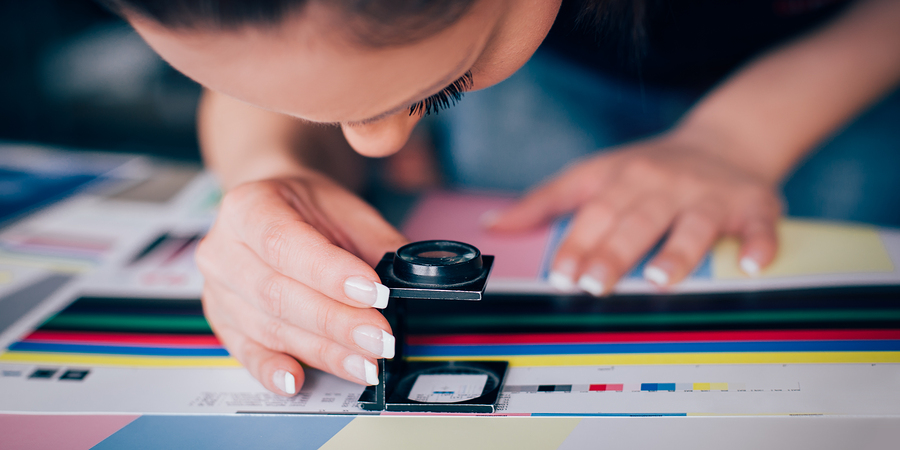In an increasingly digital world, having stunning printed materials for your business offers a renewed opportunity to capture the attention of audiences and really stand out from other brands.
Making the most of the opportunity that print offers means understanding how to print effectively. The rules of creating printed collateral are a little different to the rules around website design or digital advertising that you might be more familiar with. There are both design factors and printing factors that you should discuss both with your designer and printer prior to starting the print run, in order to avoid potentially costly mistakes and the need for a reprint.
Design factors
1. Make sure you get the technical elements right
More than anything else, making sure that your printed materials have the impact that you want them to relies on the printed page looking exactly as you visualised it on the screen. There are a couple of technical things to keep in mind to make sure you achieve that:
- Bleed: Bleed means that whatever design you come up with, you make sure that the visual assets extend a little beyond the margins of what you’ve designed. This is so the printing company can trim off the excess at the end of printing, and there’s no risk that there’s a tiny line of distracting white border at the edges.
- Creep: If you’re printing something with pages (a booklet or brochure, for example) you need to take ‘creep’ into account. The more pages something has, the thicker the printed product becomes; and the thicker the product is, the more space you’ll need from the edge of the paper in the spine to the graphics and text that you want people to see.
2. Understand how colour and design works
There are entire degrees taught based on visual design, however, there are also some basic learnings that just about anyone can master to create some great-looking promotional imagery:
- Master the colour wheel: The most important principle of them all is making sure you understand the colour wheel. This will help you grasp how each colour that you’ve used in your promotional material either complements or helpfully contrasts with, every other colour.
- Understand how white space works: Just like in web design, with printed materials, it’s often less about what you put onto the page than it is what you leave off. The most effective printed materials tend to be clean and “elegant” in approach, with plenty of white space to draw attention to only the most important bits of information to convey.
- Understand your audience: Printed materials are most effective when they speak directly to the key audience. Do a bit of research for any area where you’re looking to distribute your printed material. Learn about the local culture and landmarks, and incorporate some of that local energy into your designs.
Printing factors
1. Choose the right stock for a winning impact
Good stock achieves a number of things –for one, it feels nicer and more premium in the hand (and every brand can always do with leaving a ‘premium’ impression). Colours will look richer on good paper stock, and text will be more crisp and pleasant to read. Good, thick stock is also harder to damage, which means the printed material will last longer.
2. Understand whether your printer will use digital or offset printing
There are two approaches to printing, which can have a significant impact on the end product:
- Offset printing: With offset printing, a ‘plate’ is produced for your image, and the image is then created by ‘rolling’ ink rollers over the printing surface with that plate. This is cost-effective if you’re going to print large quantities, and has the advantage of allowing for a wider range of paper and ink types – metallic and Pantone colours, for example, are options with offset printing.
- Digital printing: Digital printing is more direct – the image is transferred directly from the digital file to the printing surface. Basically, it’s just like how home printing works, though commercial printers have far more advanced printer technology to preserve the quality of the print. Digital printing is a much faster process, and it’s the cheaper option if the print runs in shorter, as there’s no need to create a plate for the image.
Having a full understanding of the advantages and disadvantages of each approach to printing is key for meeting your budget and delivering the printing solution that you need.
3. Consider the finish and the coating
Once you’ve finalised your content and decided on whether it’ll be printed via offset or digital, you’ll also need to decide on what kind of finish and coating you’ll give your material. Finish refers to whether the paper will be smooth or rough, with a smooth finish being able to more accurately reproduce the artwork and colour that you’ve designed on the screen.
Coating meanwhile can give you that glossy or matte look on the page. Coated papers reproduce ink more faithfully than uncoated, and give the page a premium look – the easiest example of this in practice is the high quality, coated paper they use in fashion magazines to best represent the photograph. It is a much more expensive process than uncoated paper, however.
Understanding your business’s printing material
While the printing industry has got its jargon to wade through, it’s not difficult to understand how to tailor a project in order to succeed on the printed page. If it becomes a tad confusing difficult, consider potentially using a professional printing service. Not only do they generally help create higher quality finished products, printing services will always have plenty of expertise on hand to help talk you through and concerns that you might have as well. Take full advantage of that to ensure that you end up with a successful, beautiful piece of marketing collateral to take to market.

